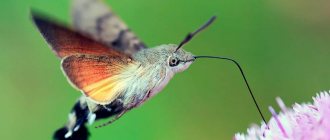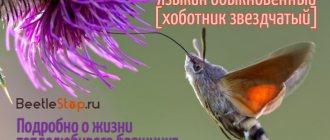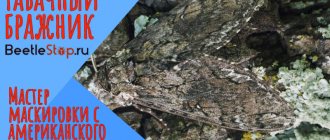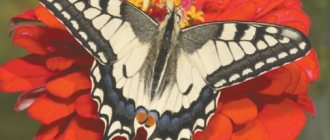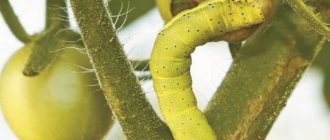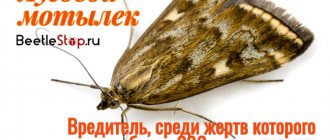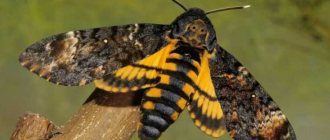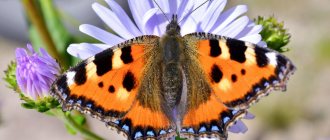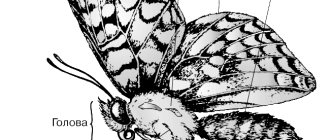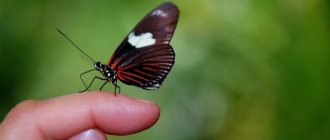a group of families of the order of butterflies, or lepidoptera (Lepidoptera), the second largest number of species in the class of insects. Most, as the name suggests, are crepuscular or nocturnal. In addition, night butterflies differ from day butterflies in their structural features. Their body is thicker, and the color of the wings is usually dull, relatively monochromatic. The antennae (antennae) are most often feathery or filamentous, while in daytime butterflies their ends are club-shaped, which is why the lepidoptera of this group are also called club-whiskers, and the moths are called moths of different antennae.
Life cycle.
Also on topic:
INSECTS
Night butterflies lay eggs singly or in groups. Females can “shoot” them on the fly, introduce them into plant tissue, or carefully place them on pre-selected objects. The eggs hatch into worm-like larvae - caterpillars - with a clearly distinct hard head, a less prominent chest, bearing three pairs of true jointed legs with a terminal claw each, and an abdomen, on which there are usually five pairs of fleshy false legs, the last one at the very end of the body. The false legs of all butterflies end in several hook-shaped bristles. After several molts, the caterpillars turn into pupae, which in most moths are enclosed in a silk cocoon woven by the larva. Silk is produced by large specialized salivary glands. They secrete a protein-rich liquid that hardens into a fiber when exposed to air. This fiber is used for weaving a cocoon, lining an underground chamber dug by a caterpillar before pupation, building shelters, and also for special methods of protection from enemies. Inside the pupa of evolutionarily advanced taxa, the appendages of the developing adult (imago) are tightly pressed to the body and cannot move. After a certain period of time, depending on the species and external conditions, an adult butterfly emerges from the pupa.
What do moths eat in the wild?
There are many varieties of lepidoptera, the adults of which do not eat at all. Their vital activity is supported by nutrients that were accumulated at the caterpillar stage.
Other moths feed on:
- nectar;
- overripe fruits;
- plant juice;
- honey.
Rare species consume the tears and blood of certain animals, as well as their excrement and sweat.
If you breed moths at home, you can prepare a nectar substitute. It can be any sweet liquid. The easiest way is to dilute a little sugar, honey or jam in water. Ripe juicy fruits are also suitable.
Oral apparatus.
Also on topic:
DAY BUTTERFLIES
The proboscis of butterflies, which folds into a flat spiral, is considered the most specialized oral apparatus in the class of insects. When not in use, it is usually hidden under thick scales. The expanded proboscis is well adapted for sucking up liquid food and its base opens directly into the pharynx. Non-feeding adults with rudiments of the oral apparatus are rare among butterflies. The most primitive representatives of this order in adulthood are armed with gnawing jaws, which are also characteristic of caterpillars of other groups of insects.
Moth (Acharia Stimulea)
This strange creature of incomprehensible color, with a bright green blanket, is a very dangerous creature. Each shoot secretes poison, and even one touch to the caterpillar can put an adult in the hospital.
And the butterfly is an ordinary night moth, almost invisible.
Wings.
Typical butterflies have two pairs of well-developed wings, densely covered with hairs and scales derived from them. However, the structure of the wings varies greatly: they can be almost completely absent (due to evolutionary degeneration), represent wide planes or narrow, almost linear structures. Accordingly, the ability of different butterflies to fly varies. In a number of forms, for example, some wavefish, the wings are reduced only in females, while males remain good flyers. Species with both winged and wingless females are known. On the other hand, there are species in which the wings are apparently normally developed, but are non-functional as flight appendages; An example of this is the silkworm, which produces commercial silk: its males and females are winged, but are not capable of flying. Probably the best developed flying apparatus is in the hawk moth family. Their rather narrow wings beat with such frequency that the butterflies not only develop high speeds, but are also capable, like hummingbirds, of hovering in the air and even flying backwards.
In a number of moths, for example some hawkmoths and all glass moths, hairs and scales on the plane of the wings are practically absent, but this does not affect the ability to fly. The wings of these species are narrow, and they do not require additional mechanical support created by the scaly cover. In other cases, the system of veins in the wings is significantly reduced, and the supporting function is performed by scales located in a special way on their surface. Some very small butterflies have wings so narrow that they probably could not provide lift if not for the long hairs bordering them. They are located so densely that they increase the area of bearing surfaces in contact with air.
The most clear structural difference between nocturnal butterflies and diurnal ones is associated with the mechanisms of coupling of the front and hind wings, i.e. synchronizing their movements in flight. Moths have two of these mechanisms. One of them is called bridle. The frenulum is a subulate-shaped projection extending from the underside of the anterior edge of the hind wing at its base. It is inserted into the so-called retinaculum on the forewing, which in males usually resembles a pocket and is located below at the anterior edge of the wing on the costal vein, and in females it looks like a tuft of setae or stiff hairs at the base of the medial vein. The second mechanism is provided by a narrow blade clinging to the rear wing on the inner edge of the front wing at its base. This structure, called yugum, is known only in a very few of the more primitive forms. In diurnal butterflies, traction is due to a growth on the hind wings that does not correspond to the frenulum. However, there are several known exceptions. One primitive day butterfly retains the frenulum, and some nocturnal butterflies have wings linked together, like day butterflies.
Rainbow Blue Swallowtail Butterfly (Pipevine Swallowtail)
The rainbow swallowtail caterpillar is a very impressive creature, looking like a horned bull.
A very beautiful and bright large butterfly lives in only one place on Earth - in the Ussuri taiga.
Organs of vision.
The main organs of vision of moths are two large compound eyes, occupying almost the entire upper part of the head. Such eyes, characteristic of most insects, consist of many identical elements independent of each other - ommatidia. Each of them is a simple eye with a lens, a light-sensitive retina and innervation. The hexagonal lenses of several thousand ommatidia of one compound eye of moths form its convex multifaceted surface. A detailed description of the structure and operation of such organs of vision would require too much space here, and it is important to note only one thing: each ommatidia, independently of the others, perceives part of the overall image, which ultimately turns out to be mosaic. Judging by the behavior of moths, their visual acuity, like that of other insects, is good at close range, but they most likely see distant objects rather blurry. However, thanks to the independent work of many ommatidia, the movements of objects within their field of vision are probably perceived even “on an enlarged scale,” since they immediately excite hundreds or even thousands of receptor nerve cells. Consequently, the conclusion suggests itself that eyes of this type are designed primarily for recording movements.
Why do butterflies strive for light?
Very often on a summer evening you can see clouds of insects swarming around a lit lamp or a burning fire. Among those who fly into the light, and often die in the flames or sitting on hot glass, there are many night moths.
Today, there are several versions of why moths fly into the light, and scientists cannot decide which one is the most likely.
As you know, light is a guide for insects. They use it to determine where to move, no matter whether the moon or a street lamp is shining.
Another version is that since butterflies usually still focus on global sources, for example, the light of the sun or other celestial bodies, the movement of the insect does not in any way affect the distance to the star, and, accordingly, the brightness of the light. If a moth flies into the light of a lamp, then as it approaches the light source it becomes disoriented and can no longer get out of the illuminated circle.
Pigmentation.
Like daytime butterflies, the coloration of night butterflies is dual in nature - structural and pigmentary. Pigments of various chemical compositions are formed in scales that densely cover the body of the insect. These substances absorb rays of a certain wavelength and reflect others, which represent the part of the solar spectrum that we see when looking at a butterfly. Structural coloring is the result of refraction and interference of light rays and is not associated with the presence of pigments. The layered structure of the wing scales and membranes, as well as the presence of longitudinal ridges and grooves on the scales, lead to the deflection and interaction of “white” solar rays in such a way that certain of their spectral components are enhanced and perceived by the observer as colors. In moths, the coloring in nature is mainly pigmentary.
Spicebush Swallowtail
At first glance, this creature looks more like a fish or lizard than a caterpillar. Huge false eyes scare away predators. In addition, during its life of a couple of months, the larva changes color - the egg hatches chocolate brown with large white spots, then becomes bright emerald, and before pupation - orange with a red belly.
The black-blue velvet butterfly is common in North America; in some places it gathers in colonies of hundreds of thousands of specimens.
Shelters.
Caterpillars from several fairly distant families of moths appear to have independently acquired similar defensive behaviors. A good example is bagworms and case-carriers. In the bagworm family, the caterpillars build silken houses with pieces of debris and leaves attached to the outside almost immediately after hatching. The structure of the shelter is such that only the front part of the larva protrudes from it, which, if disturbed, is completely retracted inside. The size of the house increases as the caterpillar grows, until it finally grows and pupates inside this “bag” of its own, reaching a length of 2.5–5 cm. After a few weeks, a winged male emerges from there, and the females of some genera remain in the house , and mating occurs with the help of a highly specialized copulatory organ, which the male inserts there. After fertilization, the female lays eggs in her sac and either dies next to them, never coming out, or, in some species, she crawls out to immediately fall to the ground and die.
Caseworm caterpillars build similar portable houses from pieces of leaves, shed larval integument and similar materials, holding them together with the secretion of the salivary glands and their excrement.
Reproduction process
Butterflies have the ability to find mates over long distances. The male can sense the female at a distance of several kilometers. This is explained by the fact that the female produces specific substances that the male is able to catch with his antennae. Some females have the ability to produce an ultrasonic signal, which can also be sensed by males at great distances.
In the reproduction of butterflies, an important role is played by the shape and color of the wings, as well as complex forms of courtship - dancing and mating flights. Some species exhibit sexual dimorphism. It is important for a normal sexual cycle, since it is easy to determine a marriage partner based on external differences. In addition, pheromones secreted by insects make it easier to find a partner.
Mating itself takes place on the ground or the surface of a plant. Its duration can vary - from 15 minutes to 1-2 hours. During mating, individuals are motionless. In addition to sperm, the female receives from the male some trace elements and proteins that are necessary for the formation of eggs.
Hairs, glands and other larval structures.
Caterpillars of some species are armed with stinging hairs or bristles. On their sharp peaks, ducts of poisonous skin glands open, the secretion of which, when injected into the enemy’s body, causes irritation of his integument. Special glands in larvae from various families moisten the body surface with a liquid that most likely has a repellent effect on the main predators dangerous to these species. Some caterpillars, if disturbed, begin to squirm violently, others curl up into a tight ball or pretend to be dead. In many cases, at the moment of danger, they fall from the branches like a stone and hang on the silk threads released during the fall. To get back, the caterpillar climbs the silk, moving through it with its oral appendages and front thoracic legs. In the larvae of many hawkmoths, the eighth abdominal segment bears large outgrowths in the form of horns on the back. The disturbed caterpillar with a sharp movement directs them towards the enemy. In many larvae, long, more or less spiny hairs, which densely cover the body, serve as effective protection against parasites and predators.
Flannel Moth
This is not a tuft of fur on a bush, but the larva of a flannel moth. Very poisonous creature!!! Under no circumstances should you touch it!
Adult flannel moths appear soft and cuddly, but they are also poisonous. Found in the USA and Mexico.
Protective devices of pupae.
The pupal stage of moths is characterized by a number of features that increase the chances of survival. Pupae resting in the soil are distinguished by an inconspicuous color that blends into the background. Silk cocoons, woven by most moths, serve as an effective device that protects against predators and parasites. The well-known silkworm has three layers. The outer layer is loose, the middle layer is dense, and the inner layer is filmy. This design makes the defenseless doll inside almost invulnerable.
Witch moth caterpillar (Phobetron pithecium)
A real caterpillar witch! Lives in orchards of both American continents. It is also called the “slug monkey” for its unusual method of movement - it crawls along one leaf and jumps onto another leaf.
Witch butterflies are also quite spectacular and large. They are nocturnal.
Protective painting.
Caterpillars and adults of moths widely use protective (cryptic) and warning (repellent) coloration. The latter attracts the attention of predators and is accordingly demonstrated by species that possess some kind of powerful defense. For example, many caterpillars are brightly colored, have an unpleasant taste caused by the secretion of special glands, or are covered with stinging hairs. The cryptic coloration, which allows them to blend into the background, is simply fantastically developed in the larvae of some species. If a caterpillar finds food on a coniferous tree, it may be virtually identical in color and shape to the needles or scales surrounding it. In other species, the larvae not only resemble small twigs in their appearance, but also rise on the branches at the moment of danger so as to further emphasize this similarity. This mechanism is characteristic, for example, of moths and some ribbon moths.
Cryptic coloration in imago moths can be illustrated by a huge number of examples. Resting individuals of some species from families distant from each other resemble heaps of bird droppings, while others blend perfectly with the granite rocks, bark, leaves or flowers on which they usually sit. Ribbon flies display bright warning colors on their hind wings in flight, but are almost indistinguishable at rest, since the cryptic pattern of the fore wings folded on the back perfectly camouflages the insect on stones or tree trunks. The wings of many moths bear spots very similar to the wide open eyes of large predators. This scares away enemies who try not to risk finding out the true size of the animal “looking” at them.
Yellow-brown early armyworm
This type of cutworm is especially harmful to fruit crops. Early cutworms live almost throughout the entire territory of Russia. Pests damage raspberries, apple trees, cherries, pears, plums, peach and various forest species.
Butterflies reach 35 millimeters in length. The color of the front wings is yellowish with a white stripe, the hind wings have a fringe. The body length of the caterpillars reaches 40 millimeters, and the pupa – 15 millimeters.
Scoop Gamma.
Females of early cutworms lay up to 900 eggs. The caterpillars of these cutworms destroy ovaries and leaves.
Industrial melanism
is one of the most interesting phenomena that has been attracting the attention of biologists to moths for many years. In populations, against the background of normally colored insects, there is often a small percentage of darker individuals (melanists). The formation of pigments in them is different from others, due to a gene mutation, i.e. is inherited. It has been noted that over the last century, the proportion of melanized forms in the populations of some species of moths has increased significantly, and this happened in industrial areas, mainly in Europe. Often, dark butterflies almost completely replace light ones, which were previously considered the species norm. Obviously, we are talking about some kind of rapidly developing evolutionary process.
A study of species with industrial melanism showed the following. The probability of survival of “normal” ones, i.e. light forms in rural areas are higher than among melanists, since it is the normal color that is cryptic in this type of environment. True, dark butterflies have a physiological advantage - they survive in conditions of nutritional deficiency (lack of some nutritional components), which is lethal for their light-colored counterparts, but, obviously, insects are faced with the danger of attack by predators more often than with an inadequate diet, so melanists do not only they do not displace normal individuals, but also remain in the minority. In industrial areas, many objects on which butterflies usually land are covered with soot, and dark coloring here camouflages better from enemies than normal light coloring. In addition, in conditions where food plants suffer from pollution, the reduced requirements of melanists for food quality become of particular importance. As a result, they displace normal butterflies in an industrial environment, and if the danger of nutritional deficiency becomes more important than attacks by predators, they sharply increase their presence in rural areas. Thus, the fundamental position of modern evolutionary theory is confirmed: genes that give an organism some advantage spread throughout the population if they do not simultaneously lead to the appearance of traits that reduce fitness. It is interesting to note that melanistic coloration, which has spread among butterflies in industrial and neighboring rural areas, is inherited as a dominant trait. The phenomenon of industrial melanism still requires further study. Being an excellent example of an evolutionary process occurring very quickly before our eyes, it makes it possible to better understand some of its fundamental mechanisms.
Spotted Apatelodes
This simply adorable furry caterpillar is extremely poisonous. By the way, her head is where there is one “feather”!
The spotted apatelodes moth is very large and buzzes loudly when it flies.
Spreading.
Moths are found on all continents except Antarctica and on most oceanic islands. Obviously, the ability of adults to fly has become the most important factor explaining the wide distribution of most species. However, some taxa have different main methods of dispersal. Thus, at high altitudes and in places very remote from the expected hatching areas, young caterpillars were caught traveling through the air on the silk threads they secreted. The spread of species is also facilitated by the attachment of eggs to logs and other objects, which are then transported, for example, by flood waters or wind. Many moths have symbiotic relationships with other species, and their habitats practically coincide with the distribution area of the “hosts”. An example is the yucca moth, which breeds in yucca flowers.
Dalcerida (Acraga coa)
The Dalcerida caterpillar appears glassy and transparent.
At the same time, the butterfly itself is very shaggy, brick-colored. Refers to moths. Lives in the tropical forests of Mexico.
Benefit.
Since the oral apparatus of the vast majority of adult moths is a soft proboscis that is not capable of piercing animal and plant tissue, the adults of these insects rarely cause harm to humans. In many cases, they feed on flower nectar, bringing undeniable benefits as pollinators of important crops.
An example of such benefit and at the same time symbiotic interdependence is the relationship of the yucca moth with yucca plants. The flower of the latter is designed in such a way that fertilization of the ovules and the development of seeds from them is impossible without the help of a pollinator. This assistance is provided by the female yucca moth. Having collected pollen from several flowers, she makes a ball out of it, which she carefully places on the stigma of the pistil, thereby ensuring the fertilization of the ovules in the ovary, where she lays her eggs. Developing yucca seeds are the only food for its larvae, which, however, eat only a small percentage of them. As a result, the complex behavior of the adults of these moths in an unusual way ensures the reproduction of very specific plants. Several species of yucca moths are known, each of which is symbiotically associated with one or more species of yucca.
Black Swallowtail
The caterpillar of the black swallowtail is very bright and noticeable - so that predators do not covet it. Although in fact it is quite edible.
This is undoubtedly one of the most beautiful European butterflies. During the flight, you can see how the color of the wings of the black swallowtail shimmers.
Harm.
Caterpillars of moths are very voracious. They can damage leaves, stems and roots of plants, eat stored food products, and spoil various fibers and other materials. The larvae of many species of moths cause significant damage to agriculture.
The harm of keratophagous moths is well known to everyone. They lay eggs on wool and fur, which their larvae feed on. The fibers of these materials are also used by some species to build pupal cocoons.
Malicious pests are grain moth, or barley moth, Indian flour moth and mill moth, which destroy grain in warehouses. All three species are cosmopolitan, i.e. They are distributed almost all over the world, and to reduce the damage they cause, it is necessary to constantly treat with insecticides.
Caterpillars of many species belong to the so-called group. leaf miners (from the English miner - miner) - they feed on plant tissues deep in the leaf and for this they gnaw through long winding passages and extensive cavities under its epidermis. The larvae of other species make tunnels inside branches, roots and trunks, spending their entire immature life inside the host plant, which provides pests with reliable protection from parasites, predators and humans trying to fight them.
Probably the most noticeable type of damage caused by caterpillars to plants is defoliation, i.e. destruction of foliage. Hungry butterfly larvae can literally strip fields, vegetable gardens and even forests.
What does a meadow moth look like?
The meadow moth is a moth. This is a small insect of gray-brown color, with a wingspan of 18 to 26 mm. The wings have a pattern of yellow stripes. The insect is a dangerous pest, affecting a large number of agricultural plants.
Reproduction nuances
After mating, the female lays eggs. During its life, a butterfly can lay up to 600 eggs. The laying is done on the underside of the leaves of the food plant. After 2–15 days, caterpillars emerge from the eggs. They immediately start eating and grow quickly. The caterpillar stage lasts from 10 to 30 days, after which the larva burrows into the ground and pupates. The insect spends from 7 to 35 days in the cocoon, and then the meadow moth is born.
Maliciousness
Meadow moth caterpillars feed on both cultivated and wild plants and weeds. Voracious pests cause damage to crops such as:
- sugar beet;
- buckwheat;
- alfalfa;
- perennial legumes;
- corn;
- peas;
- sunflower;
- potato;
- barley;
- wheat, etc.
Meadow moth caterpillar
With extensive infestation, the larvae can destroy the entire crop.
How to fight a moth?
Measures to combat the meadow moth differ little from methods of getting rid of other pests and include:
- agrotechnical measures (digging soil in autumn and early spring, removing weeds, hilling);
- biological methods (use of trichograms and biological products);
- chemical methods (use of insecticides).
You can add to the main control measures the manual collection of caterpillars and the use of folk remedies.
Buy live butterflies in our store
Our online store offers you to buy real tropical butterflies at competitive prices in Moscow. Live butterflies for breeding and simply lifting your spirits are the best gift for any occasion.
Surprise your loved one by giving him a whole fireworks display of live butterflies
We also have not forgotten about true connoisseurs and collectors of this beauty: our decorative butterflies, spectacularly framed in a beautiful frame, will not leave indifferent even the most experienced entomologists who have visited all corners of the globe. By purchasing butterflies from us, you guarantee a good mood to any gift recipient.
Butterflies are an ideal way to create a good mood
( 2 ratings, average 5 out of 5 )
Centenarians
Some of the most famous representatives of the butterfly species are. These insects can live as adults for about one year. This is truly a record for life expectancy among butterflies.
Another type of record holder that cannot be ignored when answering the question “How long do butterflies live at home” are representatives of the lemongrass species. This type of insect can live for more than a year, withstanding even severe frosts down to minus 20 degrees.
One of the most famous representatives of the butterfly species is the Monarch butterfly. These insects can live as adults for about one year. This is truly a record for life expectancy among butterflies.
Saturnia Io (Automeris io)
Incredible bright green caterpillar with pompoms. Distributed in Canada and the USA. Very poisonous. The Indians used it to lubricate their arrows.
The colorful moth is also quite impressive, especially at night when those “eyes” glow.
Factors influencing life expectancy
Monarch butterflies are unique representatives of their species. They live in the adult stage from nine to a year, setting an unspoken record in the world of lepidopteran data.
The life cycle of the Brixton butterfly lasts for ten months. True, unlike the above-mentioned relatives, this applies mainly to its presence in the form of a caterpillar and pupa.
The shortest lifespan is given to pigeons - only a few days. The cabbage white, a typical Russian representative, has the opportunity to flutter around natural spaces for about twenty days. By the way, it earned its name due to the fact that cabbage is one of the components of feeding the caterpillar of this insect.
butterflies in the tropics
- How to determine the sex of a budgerigar?
- How to accustom a parrot to your hands?
- What name can you call a snake?
- How to care for ferrets?
- American Wirehair: character traits
- Food Taste of the wild: types, composition, reviews and price
- How long does estrus last in dogs - signs, symptoms and rules of care during this period
- Drontal for dogs - indications and contraindications, cost and description
northern butterfly
northern butterfly
general information
The scoop, what is it, is a butterfly - a moth from a very large family, which consists of 15 subfamilies and over 35 thousand species. Night owls belong to the even larger order Lepidoptera , which is represented by a huge number of moths, butterflies and moths.
Cutworm pests are considered the most dangerous and malicious insect of various cultures , despite their absolutely harmless appearance.
The behavior of the hawk moth
This representative of the Lepidoptera family is rightfully recognized as a nocturnal resident. In daylight, the butterfly lives on the surface of tree bark and in thickets of bushes.
Due to the peculiarities of the blood supply (cold-blooded insects), before flying, the hawk moth needs to heat its wings and body to the required temperature, so you can see how the butterfly flaps its wings for a long time and quickly.
In temperate regions, hawk moths pupate before the onset of winter cold. In the autumn season or early spring, the butterfly hides in layers of moss or the top layer of soil to wait out the temporary cold. Today, several subspecies are known, which are characterized by seasonal migration.
What does it eat?
During the period of flight and mating, the imago feeds on pollen of flowering plants without causing them the slightest damage. The armyworm and its caterpillars are a serious problem, eating above-ground parts and destroying plants.
Cutworm caterpillars fall into three categories:
- Intrastem - settle in thick stems and feed on their contents, causing the death of the entire plant.
- Gnawing - live in the ground, gnawing roots and basal parts.
- Leaf-eaters - live on plants, eating all the green mass - leaves, young stems and shoots, buds and inflorescences. Most representatives of the noctuid species fall into this category.
Owl butterfly photo.
What plants does it damage?
The noctuid family consists almost entirely of polyphages. The cutworm is classified as a pest of cereals, vegetables, ornamentals, fruit pome and stone fruits , industrial crops, legumes, cruciferous crops, oilseeds, berries, conifers, greenhouse crops, greenhouse crops, grapevines, perennial grasses, lawns, nurseries and meadows.
In general, we can say that the percentage of plants that do not attract cutworm caterpillars is very small .
